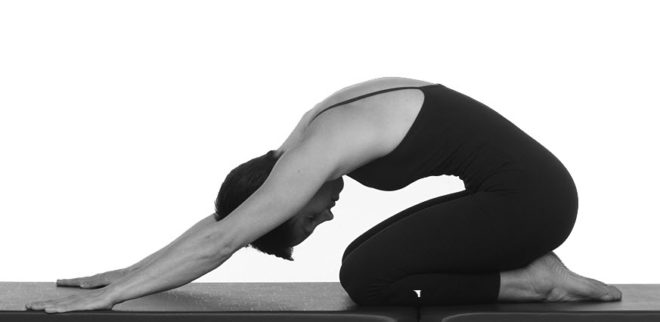Some may mistake this position for a yoga pose or a simple stretch. But Rest Position is essential to transition in every level of our practice. Learn how to properly execute this position and let your heart melt into rest!
While Rest Position is not technically an exercise, it is part of the transition that comes after extension in the classical mat. It is found after Swan I – Neck Roll in Level I, moves to after Double Leg Stretch in Level II, and stays there for Level III. After the rush of the holidays it’s nice to take a look at rest and how to get it right. While it is called rest, it is not the time to collapse and hang in the body. After all, it comes mid-way through the mat workout.
Goals:
- Provide a counter stretch to extension and stretches the low back
- Allow for an opportunity to reconnect to the breath.
Getting it Right:
Let’s look at this one step at a time…
- From your last repetition, place your hands under your shoulders and pull back through your waist, curling back, to sit with your seat on your heels. Keep your arms long and reaching away from you, palms to the mat.
- Initiate: Inhale. Breathe into the low back and let it expand. Exhale, scoop deeply lifting the abs away from the thighs. Repeat for 3 breaths.
Instead of hanging, activate to give the low back a deeper stretch!
Checkpoints:
- Lengthen the entire length of the spine letting the crown move one way and the tail the other.
- Keep the tail curled under a bit.
- Allow the cervical spine to continue the line of the thoracic and lumbar spine.
- Let the head and neck relax.
- Do not allow the knees to widen outside of the frame. Keep the sitz bones in line with the heels.
- Work the breath to connect to the stretch and the powerhouse.
What Can Go Wrong:
When entering Rest Position, try to pull back through the waist instead of simply pushing with the arms. Pulling back and curling the spine into a round position will give a very different and richer experience of this positions. Students confuse this with ‘child’s pose’ from yoga. It is not. They have very different shapes and purposes. Keep the abdominals deeply activated.
If students have pain sitting back and performing deep knee flexion, slip a rolled up yoga mat or foam roller under the seat and over the calves, or substitute lying on the back and hugging the knees to the chest.
As we head into Valentine’s Day, let your heart melt into rest – and give your back a stretch!



